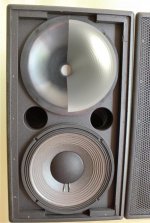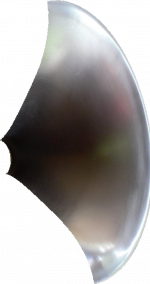Solo
performances. This is why a center channel is used in some systems. Also for uniform pans across a wide stage. WHG
I've heard some people listen to their speakers in mono to tune them. I've also seen a post somewhere around the internet about the caveats to doing this. Is there a detailed explanation somewhere or can someone explain when listening in mono might be useful?
performances. This is why a center channel is used in some systems. Also for uniform pans across a wide stage. WHG
Last edited:
If I measure the response at every point in a room then I have an exact calculation of the power response. If I measure this at a single point then there is an expected error of +6 dB to -11 dB. That is hardly good enough to rely on as a measure of the power response. As I add N more uncorrelated points to the average the error will go down as 1/N (linearly.) At some point I will get an answer that is "good enough." We found years ago that it took about 18 points to get a 1 dB error. Six gets you about 3 dB.
Earl, may I get your interpretation please. Floyd Toole said the following in 2019
Some are interpreting this to mean that diffraction is not important. How would you respond to that assertion?
How to Choose a Loudspeaker -- What the Science Shows | Page 90 | AVS ForumFloyd Toole said:The audibility of acoustical interference depends entirely on its origin. If it is diffraction from enclosure edges or design features the measured evidence will be different for every mic location around the speaker. It averages out, sometimes within the listening window measurements. A room with normal reflections assists in disguising the problem. Such interferences should be avoided, but in practice they often are not consequential audible problems. If the interference originates in the crossover between adjacent transducers the directional variations will be less and the consequence will be variations in acoustical output. These will show up in more of the curves in a spinorama and are definitely audible.
Some are interpreting this to mean that diffraction is not important. How would you respond to that assertion?
If I measure the response at every point in a room
Mic axis angle random to speaker axis?
I'm interested in seeing Earl's take, but I disagree with comments that it's not important (I don't visit that site, so haven't read them). To me it depends on two things, the first arrival impact and the power (room) response. If the on-axis is designed to be flat on-axis, the off-axis response may be problematic. The contribution to the off-axis responses will show up in the power response. My take on his comments is that they are with regard to room reflections. Those average out, but are best avoided, as he says. I don't interpret his comments to mean that it's not important.Earl, may I get your interpretation please. Floyd Toole said the following in 2019 How to Choose a Loudspeaker -- What the Science Shows | Page 90 | AVS Forum
Some are interpreting this to mean that diffraction is not important. How would you respond to that assertion?
Dave
Earl, may I get your interpretation please. Floyd Toole said the following in 2019 How to Choose a Loudspeaker -- What the Science Shows | Page 90 | AVS Forum
Some are interpreting this to mean that diffraction is not important. How would you respond to that assertion?
Toole said "... in practice they often are not consequential audible problems."
That means only that it's possible that they're not be important.
This is a bit like saying: If the system is ****** enough, you're not going the hear the extra ******ness.A room with normal reflections assists in disguising the problem. Such interferences should be avoided, but in practice they often are not consequential audible problems.
The audible distortion is basically covered with more distortion.
IMO, we have to move away from comments like this if we have high-fidelity and perfection in mind and not simply listening to music causally in the background somewhere random in the room.
Earl, may I get your interpretation please. Floyd Toole said the following in 2019
"The audibility of acoustical interference depends entirely on its origin. If it is diffraction from enclosure edges or design features the measured evidence will be different for every mic location around the speaker. It averages out, sometimes within the listening window measurements."
Some are interpreting this to mean that diffraction is not important. How would you respond to that assertion?
Floyd's first sentence is certainly true, as is the second, but the second clearly refers to measurements not perception as the first one does. Hence this is not a claim of diffraction perception only that it is difficult to measure as the third sentence also implies. Although I am not 100% sure that everything will average out, none-the-less just because something is difficult to measure does not mean that it is inaudible. Anyone reading this who's take-away is that diffraction is not audible has clearly not read it carefully. Floyd is always careful about what he says that's one of the things I admire most about him. I wish that I were more careful sometimes.
Mic axis angle random to speaker axis?
I don't understand the question "measure at every point in a room" does not equate to "Mic axis angle random to speaker axis?"
Toole said "... in practice they often are not consequential audible problems."
That means only that it's possible that they're not be important.
Yes, and as Omholt say's what is an audible problem depends on what other problems exist and what one is looking for.
For example we know that wide directivity enhances spaciousness and will also tend to "cover up" early diffraction effects. But these two things also degrade imaging. So if the choice is audible diffraction or enhanced spaciousness but a degraded image then many will likely prefer the wide directivity and thus diffraction is not an issue anymore.
But if one wants to improve imaging by limiting the VER, then diffraction is likely going to be an issue in this case.
Think of diffraction as Very Very Early reflections. micro-seconds of delay, not milli-seconds as reflections are. This will mess up the brains ability to sort out image as these diffractions get fused into the direct sound - unlike room reflections which usually arrive late enough in time to be considered as distinct sound arrivals.
Thanks for your input, it is appreciated.
IMHO if some claim a preference for spaciousness without first having this experience, it may not be clear what this represents. Just one possibility, maybe early reflections can make a not so good speaker or implementation just a little more tolerable to listen to?
I am one that does not (a clean image is what I had always been looking for). In order to realise this it was necessary to take the advice here, and then to pursue designs where low diffraction and early room interaction was a primary goal. Then to use this knowledge to refine the design, integrate with the room and voice the speaker. I have confidence in this process as those that have also done it will know.So if the choice is audible diffraction or enhanced spaciousness but a degraded image then many will likely prefer the wide directivity
IMHO if some claim a preference for spaciousness without first having this experience, it may not be clear what this represents. Just one possibility, maybe early reflections can make a not so good speaker or implementation just a little more tolerable to listen to?
<snip> (a clean image is what I had always been looking for). <snip>
IMHO if some claim a preference for spaciousness without first having this experience, it may not be clear what this represents. Just one possibility, maybe early reflections can make a not so good speaker or implementation just a little more tolerable to listen to?
I share that opinion. Spaciousness, without first having achieved precise imaging, is a formula for pleasant mediocracy, ime/imo.
Comes from time blurring i think, ....and can come in several ways, which are all time related.
- Home
- Loudspeakers
- Multi-Way
- Geddes on Waveguides

